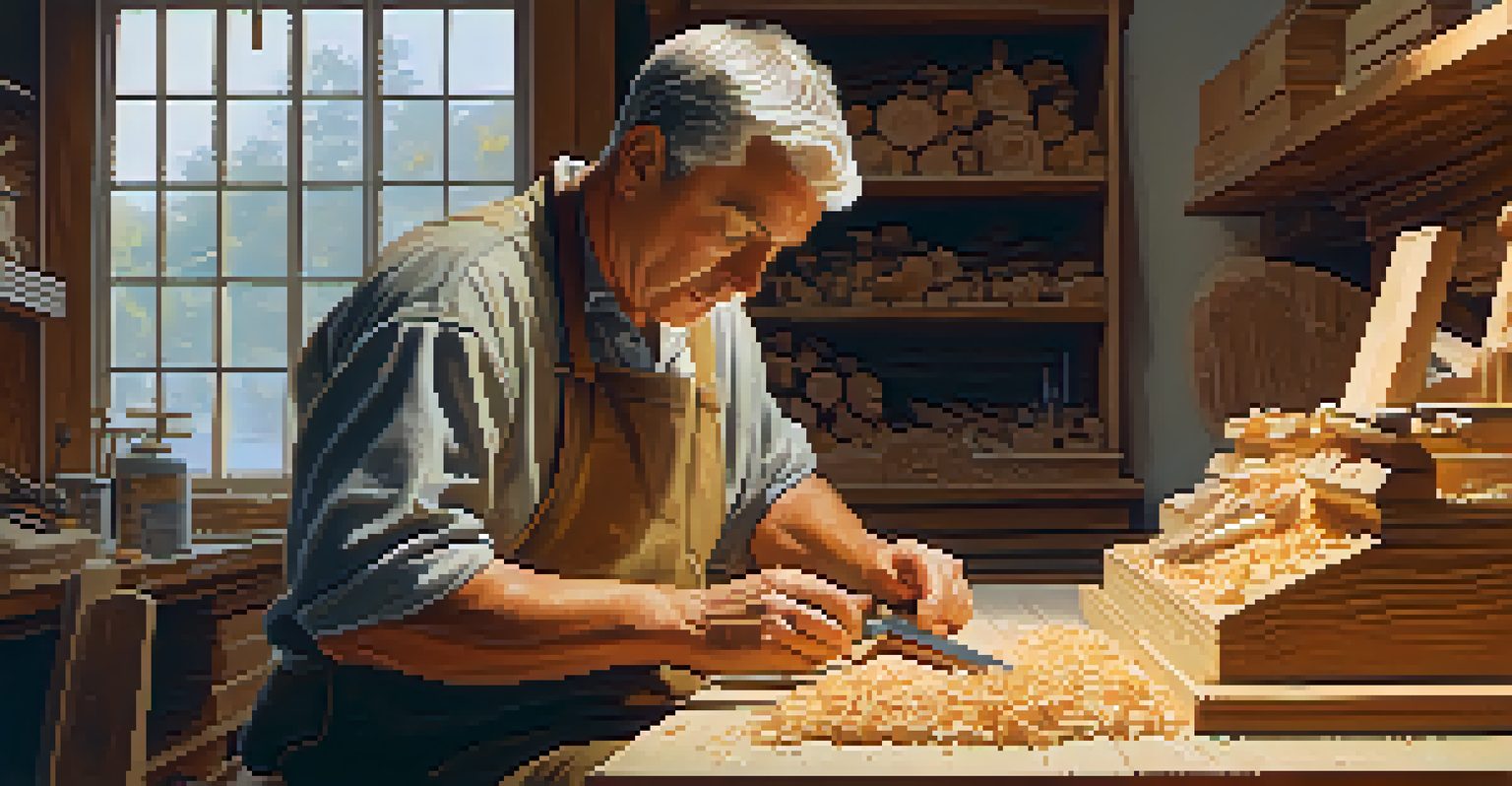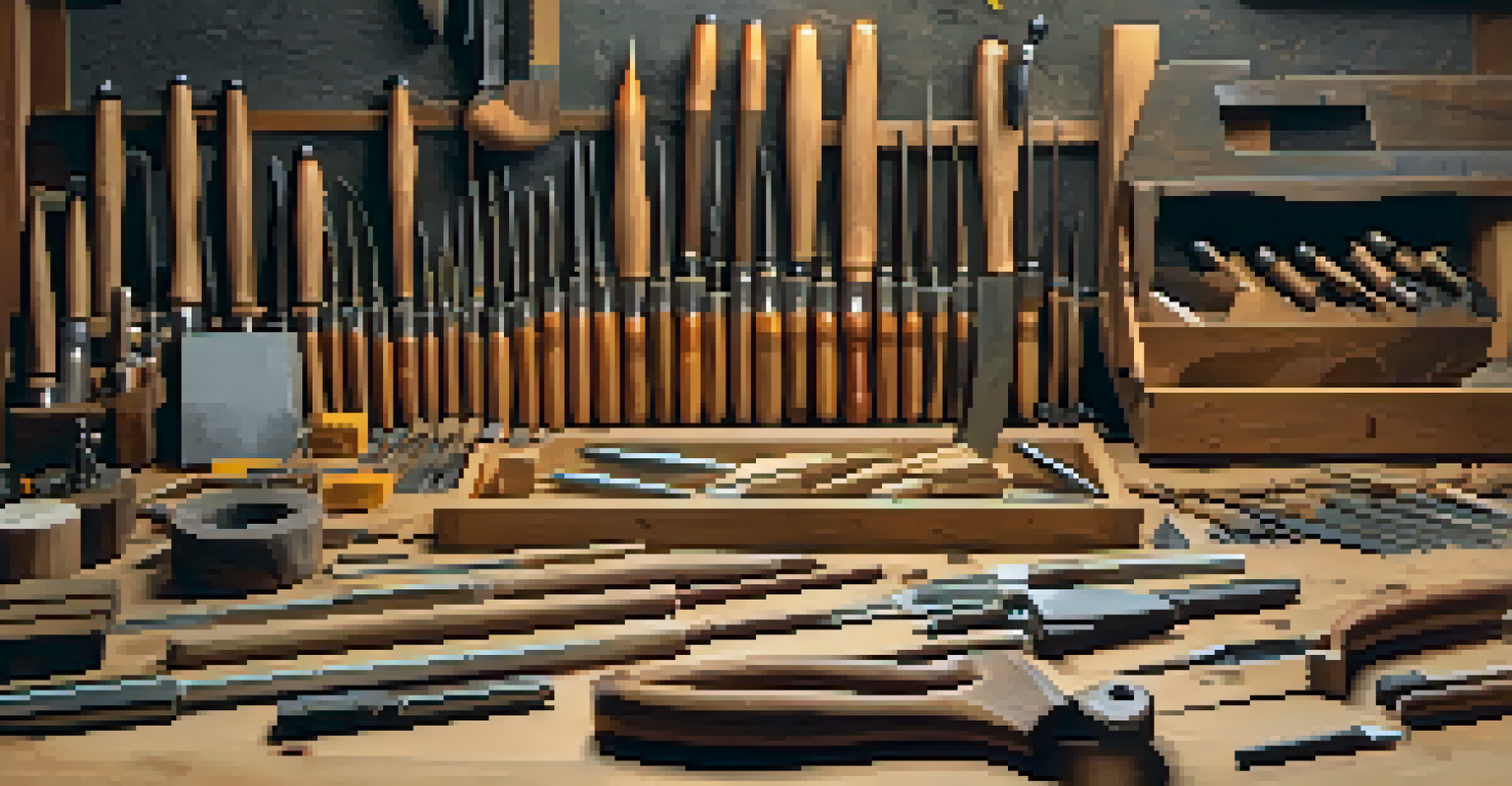Carving Tools Explained: A Beginner's Introduction to Carving

Understanding the Basics of Wood Carving Tools
Wood carving is an art that requires the right tools for precision and creativity. At its core, carving involves shaping wood into intricate designs, and the tools you choose can significantly affect your results. For beginners, understanding the basic types of tools available is crucial to starting your carving journey.
Every artist was first an amateur.
Common tools include knives, chisels, and gouges, each designed for specific tasks. A carving knife, for example, is great for detailed work, while chisels can tackle larger sections of wood. By familiarizing yourself with these tools, you'll be better equipped to select the right ones for your projects.
As you begin, remember that investing in a few quality tools is more beneficial than having a large collection of subpar ones. Durability and comfort should guide your choices, ensuring that your carving experience is enjoyable and productive.
Essential Carving Knives for Beginners
Carving knives are perhaps the most important tools in a woodcarver's arsenal. A good carving knife should feel comfortable in your hand, allowing for precise cuts without causing strain. Look for a knife with a sturdy blade and a comfortable handle that suits your grip style.

When starting out, you might consider a basic whittling knife, which is great for both roughing out shapes and adding details. As you progress, you can explore specialty knives like detail knives or chip carving knives. Each type offers unique capabilities that can enhance your projects.
Choose Quality Carving Tools
Investing in a few high-quality carving tools rather than many subpar ones enhances your carving experience and results.
Practicing with your carving knife regularly will help you become more skilled and confident. Remember, the more you carve, the better you'll understand how to manipulate the tool effectively, making your work more enjoyable.
Exploring Chisels: Types and Uses
Chisels are versatile tools that can add depth and detail to your wood carving projects. There are various types of chisels, including flat, V-shaped, and skew chisels, each serving a different purpose in the carving process. Understanding these differences will help you choose the right chisel for your specific needs.
The only way to do great work is to love what you do.
Flat chisels are ideal for smoothing surfaces and removing larger amounts of wood, while V-shaped chisels excel in creating intricate details and grooves. Skew chisels, on the other hand, are great for making angled cuts and producing fine lines. Each type of chisel opens up new possibilities in your carving.
As you work with chisels, remember to maintain a sharp edge for optimal performance. Regular sharpening not only improves your results but also makes carving safer and more efficient.
The Role of Gouges in Wood Carving
Gouges are specialized tools that allow carvers to create unique shapes and textures in their woodwork. The shape of the gouge's blade determines its function; for example, a U-shaped gouge is perfect for hollowing out areas, while a spoon gouge is ideal for carving bowls and curved surfaces. Understanding these shapes will help you utilize gouges effectively.
Using gouges can feel different from knives and chisels, requiring practice to master their techniques. Start with simple projects that allow you to experiment with different gouge shapes and learn how they interact with the wood. Over time, you’ll develop a feel for how to control the tool.
Understand Tool Types and Uses
Familiarizing yourself with the different types of carving tools—knives, chisels, and gouges—helps you select the right ones for your projects.
Incorporating gouges into your toolkit can significantly expand your carving capabilities. They help you achieve a variety of textures and forms, allowing for more creativity in your designs.
Safety Tips for Beginners in Wood Carving
Safety should always be a top priority when carving, especially for beginners. Start by ensuring you have a safe workspace, free from distractions and hazards. A stable surface and proper lighting can make a significant difference in how comfortably and safely you carve.
Wearing protective gear, such as gloves and goggles, can help prevent injuries. Additionally, always carve away from your body and maintain control of your tools. Developing safe habits early on will help you avoid accidents and enjoy the process.
Finally, take your time and don’t rush your projects. Carving is a skill that develops gradually, and patience is key. By respecting both the tools and the wood, you can create beautiful pieces while staying safe.
Choosing the Right Wood for Your Projects
The type of wood you select can greatly influence your carving experience and the final outcome of your work. Softwoods, like pine or basswood, are often recommended for beginners due to their ease of carving. These woods allow for quick progress and are forgiving for those still honing their skills.
As you gain confidence, you might explore hardwoods, such as oak or cherry, which offer unique challenges and rewards. Hardwoods can produce stunning results but may require more advanced techniques and tools. Understanding the properties of different woods will help you make informed choices for your projects.
Prioritize Safety in Carving
Establishing safe carving habits, such as proper workspace setup and protective gear, is essential for preventing injuries.
Always consider the grain and texture of the wood as well. A wood's characteristics can affect how it carves, so experimenting with various types will enhance your understanding and appreciation of the medium.
Tips for Maintaining Your Carving Tools
Proper maintenance of your carving tools is essential for longevity and performance. Regularly sharpening your knives, chisels, and gouges will ensure they cut cleanly and efficiently. A sharp tool is not only safer but also makes the carving process more enjoyable.
Cleaning your tools after each use is equally important. Wood shavings and debris can accumulate and cause rust or damage. A simple wipe with a cloth and occasional oiling can protect your tools and keep them in top condition.

Lastly, storing your tools correctly can prevent damage. A dedicated toolbox or a protective case can help keep your tools organized and safe from accidents, ensuring that they are ready for your next carving adventure.